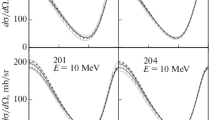Abstract
We explore the validity of using nonrelativistic wave functions for lightly-bound states in relativistic situations. This is shown to be acceptable for scattering problems, but not necessarily for those involving a decay. In the latter case the wave function would need to have special properties. These do not occur for a deuteron-like wave function but do occur for a positronium-like system, the crucial features being that positronium is bound by zero mass exchange.
Similar content being viewed by others
References
Much of the material in this section is similar to what has previously been described by P.V. Landshoff, J.C. Polkinghorne: Phys. Rev.D18, 153 (1978) or I. Schmidt, R. Blankenbecler: Phys. Rev.D16, 1318 (1977)
In more old-fashioned language, this result is equivalent to saying that atq 2=0 the form factor is dominated by its triangle singularity represented by Fig. 1: See R.J. Eden et al.:The analytic S-matrix, Sect. 2.3. Cambridge: Cambridge University Press 1966
The vertex functionV does have an anomalous threshold, but this is harmless (see [2])
For a recent review of such processes, with references to earlier work, see W. Celemaster: 1980 Madison Conference talk, preprint ANL-HEP-CP-80-60
Because of the zero mass of the photon, the branch points in Fig. 3 now coalesce with the poles giving a cut starting atk 22 =m 2 and a cut startingk 21 =m 2. Neark 22 =m 2 the cut can be parametrised by (k 22 −m 2)β−1 where β=αv 2 (see [6]). In the region of interest the velocity ν∼α and so the discontinuity across the cut is strongly peaked near the beginning and the dominant contribution comes from setting β=0 and approximating the cut by the original pole
T.W.B. Kibble: Phys. Rev.173, 1527 (1968)
G.P. Lepage, S.J. Brodsky: SLAC-PUB-2478
E.C. Poggio, H.J. Schnitzer: Phys. Rev.D20, 1175 (1979)
C. Michael, F.P. Payne: Phys. Lett.91B, 441 (1980)
T. Appelquist, M. Dine, I.J. Muzinich: Phys. Rev.D17, 2074 (1978)
A. Martin: Phys. Lett.93B, 338 (1980)
—: J. Dias de Deus: Phys. Lett.98B 301 (1981)
Author information
Authors and Affiliations
Rights and permissions
About this article
Cite this article
Donnachie, A., Horgan, R.R. & Landshoff, P.V. Nonrelativistic wave functions in relativistic physics. Z. Phys. C - Particles and Fields 10, 71–76 (1981). https://doi.org/10.1007/BF01545785
Received:
Issue Date:
DOI: https://doi.org/10.1007/BF01545785



